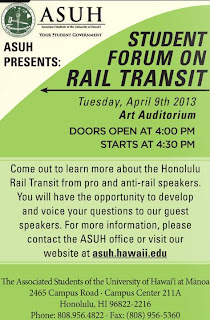The Brookings Institution, rated No. 1 think tank in the world, published the Global Metro Monitor update which “provides economic growth data.” Where does Honolulu rank among 300 cities? It ranks 284th for the 1993 to 2007 period, and 217th for the 2007 to 2011 period. Honolulu ranks 54th in terms of population in the U.S.
While Honolulu ranks 284th, for the same period Portland ranks 93rd, Tucson ranks 100th, Tampa ranks 106th, Salt Lake City ranks 130th and depressed Cincinnati ranks 206th. Honolulu is much closer to 297th ranked New Orleans than any of its peer cities.
Why is Honolulu ranking so low? In large part because of the excessive waste of funds on unproductive endeavors. Unfortunately, this is a lesson that has not been learned.
Here is a list of 10 large mistakes:
1. We invested in the 2nd city and more housing. As a result we get worse congestion and continuously escalating housing prices because of land controls. Creating a 100,000 population city on prime agricultural land is a mistake that Honolulu county will be paying for, for centuries.
2. We invested in buses: 200 more buses, express buses, and HandiVan in the last 30 years. Yet we got flat ridership. In 1980 Honolulu had 760,000 residents and TheBus carried 71.6 million trips, or 7.5 trips per resident per month. In 2010 Honolulu had 960,000 residents and TheBus carried 73 million trips, or 6.4 trips per resident per month, a 15% drop in per capita productivity. Transit is a declining business.
3. The last thing we need is a multi‐billion dollar investment in transit. But that’s a local priority!
4. We invested in high-occupancy and zipper lanes but we don’t do anything to manage the flow on them. As a result drive alone and carpool share was 81% in 1990 and 81% in 2012. More people drive alone now than 20 years ago, despite the tripling of fuel prices. Carpooling has lost share because the freeway HOV lanes provide a low travel time benefit.
5. We invest in government. As a result we get over-regulation and slow innovation. Many government operations in Hawaii still use carbon copying and physical walking of papers from place to place, then pay extra workers to enter the information on a computer.
6. A private consortium launched the Superferry. The supermajority of people loved it. Corporatist politicians and special interests killed it.
7. We invest in junk renewables like concentrated solar. Taxpayers paid millions in tax credits to a company on the Big Island that installed 1,008 panels on four acres of land to produce 0.1 MW which is mostly used internally and no power is sold to HELCO!
8. We do not invest much in tourism, infrastructure upkeep, congestion relief and park cleanliness. Despite the brouhaha about our banner 2012 year for tourism, the fact is that growth in tourism has not kept up with Honolulu’s modest growth in population: In 1990 we had about 8 visitors per local resident. In 2010 we had 7.25 visitors per local resident. Taxes generated from tourists do not keep up with local needs for services on a per capita basis.
9. Now we want to invest in "one iPad for each public school student" as if Apple can stuff knowledge in pupils’ brains.
10. We also want to invest in one super-casino so we can collect voluntary money losses from gamblers. We seem to know how to get from 284th to 300th.
What if we wanted to improve our ranking (and our quality of life)?
First we need to place our trust on data and not on “visionaries.” Given Hawaii’s great loss in Congressional seniority, an
economic decline followed by bumpy stability will be the trend as I explained previously. Honolulu’s basic 0.5% annual growth will be flattened by local, national and international pressures.
Then proceed with this sample half dozen of economically productive actions:
1. Plans focused on growth for Oahu must be abandoned.
2. Top Priority: Maintain, Rehabilitate, Replace, Modernize.
3 Scrap rail. Use $3 billion to fix roads and add express lanes and urban underpasses.
4. Scrap wind. Focus on natural gas, waste‐to‐energy and geothermal.
5. Scrap the EPA agreement for secondary sewage treatment. (Many cities are taking EPA to task for its unreasonable consent decrees.) Focus on accelerated replacement of water and sewer lines.
6. Manage current and future budgets to sustain item 2.
[Also published in
Hawaii Reporter.]



























